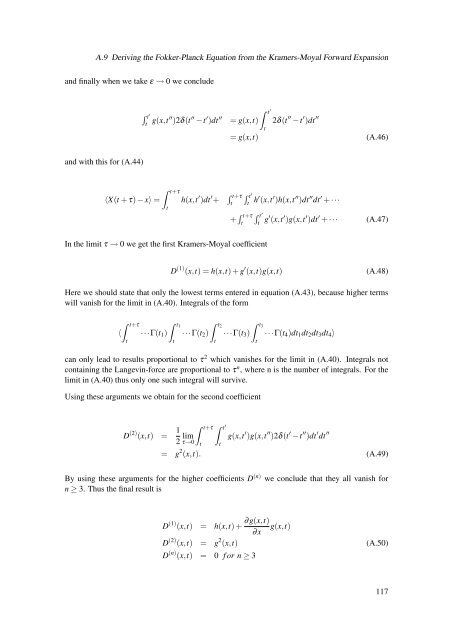Diffusion Processes with Hidden States from ... - FU Berlin, FB MI
Diffusion Processes with Hidden States from ... - FU Berlin, FB MI
Diffusion Processes with Hidden States from ... - FU Berlin, FB MI
You also want an ePaper? Increase the reach of your titles
YUMPU automatically turns print PDFs into web optimized ePapers that Google loves.
A.9 Deriving the Fokker-Planck Equation <strong>from</strong> the Kramers-Moyal Forward Expansionand finally when we take ε → 0 we conclude´ t′tg(x,t ′′ )2δ(t ′′ −t ′ )dt ′′ = g(x,t)ˆ t′t2δ(t ′′ −t ′ )dt ′′= g(x,t) (A.46)and <strong>with</strong> this for (A.44)〈X(t + τ) − x〉 =ˆ t+τth(x,t ′ )dt ′ +´ t+τ ´ t′t th ′ (x,t ′ )h(x,t ′′ )dt ′′ dt ′ + ···+´ t+τt´ t′tg ′ (x,t ′ )g(x,t ′ )dt ′ + ··· (A.47)In the limit τ → 0 we get the first Kramers-Moyal coefficientD (1) (x,t) = h(x,t) + g ′ (x,t)g(x,t)(A.48)Here we should state that only the lowest terms entered in equation (A.43), because higher termswill vanish for the limit in (A.40). Integrals of the form〈ˆ t+τt···Γ(t 1 )ˆ t1t···Γ(t 2 )ˆ t2t···Γ(t 3 )ˆ t3t···Γ(t 4 )dt 1 dt 2 dt 3 dt 4 〉can only lead to results proportional to τ 2 which vanishes for the limit in (A.40). Integrals notcontaining the Langevin-force are proportional to τ n , where n is the number of integrals. For thelimit in (A.40) thus only one such integral will survive.Using these arguments we obtain for the second coefficientD (2) (x,t) = 1 2 limτ→0ˆ t+τ ˆ t′ttg(x,t ′ )g(x,t ′′ )2δ(t ′ −t ′′ )dt ′ dt ′′= g 2 (x,t). (A.49)By using these arguments for the higher coefficients D (n) we conclude that they all vanish forn ≥ 3. Thus the final result isD (1) (x,t) = h(x,t) + ∂g(x,t) g(x,t)∂xD (2) (x,t) = g 2 (x,t) (A.50)D (n) (x,t) = 0 f or n ≥ 3117









